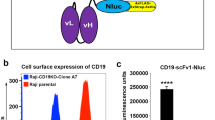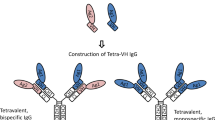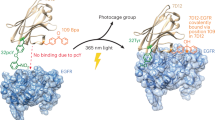Abstract
We have constructed chimeric receptors, combining murine IgM and the cytoplasmic portion of human epidermal growth factor receptor (EGFR), with the aim of developing a novel immunosensor with antigen–dependent phosphorylation activity. When intact IgM was used, the chimeric receptor showed both antigen binding and protein tyrosine kinase activity, but the kinase activity was constitutive and independent of antigen binding. However, with 1gM lacking the CH2 domain, the autophosphorylation activity increased with increasing concentrations of anti–IgM or hapten–BSA conjugate. Monovalent hapten could not induce phosphorylation but inhibited stimulation by hapten–conjugated BSA.
This is a preview of subscription content, access via your institution
Access options
Subscribe to this journal
Receive 12 print issues and online access
$209.00 per year
only $17.42 per issue
Buy this article
- Purchase on Springer Link
- Instant access to full article PDF
Prices may be subject to local taxes which are calculated during checkout
Similar content being viewed by others
References
Neuberger, M.S., Williams, G.T. and Fox, R.O. 1984. Recombinant antibodies possessing novel effector functions. Nature 312: 604–608.
Williams, G.T. and Neuberger, M.S. 1986. Production of antibody-tagged enzymes by myeloma cells: application to DNA polymerase I Klenow fragment. Gene 43: 319–324.
Schnee, J.M., Runge, M.S., Matsueda, G.R., Hudson, N.W., Seidman, J.G., Haber, E. and Quertermous, T. 1987. Construction and expression of a recombinant antibody-targeted plasminogen activator. Proc. Natl. Acad. Sci. U.S.A. 84: 6904–6908.
Flanagan, J.G. and Leder, P. 1988. Neu protooncogene fused to an immunoglobulin heavy chain gene requires immunoglobulin light chain for cell surface expression and oncogenic transformation. Proc. Natl. Acad. Sci. U.S.A. 85: 8057–8061.
Shin, S.U. and Morrison, S.L. 1990. Expression and characterization of an antibody binding specificity joined to insulin-like growth factor 1: Potential applications for cellular targeting. Proc. Natl. Acad. Sci. USA. 87: 5322–5326.
Ullrich, A., Coussens, L., Hayflick, J.S., Dull, T.J., Gray, A., Tam, A.W., Lee, J., Yarden, Y., Libermann, T.A., Schlessinger, J., Down-ward, J., Mayes, E.L.V., Whittle, N., Waterfield, M.D. and Seeburg, P.H. 1984. Human epidermal growth factor receptor cDNA sequence and aberrant expression of the amplified gene in A431 epidermoid carcinoma cells. Nature 309: 418–425.
Merlino, G.T., Ishii, S., Whang-Peng, J., Knutsen, T., Xu, Y., Clark, A.J.L., Stratton, R.H., Wilson, R.K., Ma, D.P., Roe, B.A., Hunts, J.H., Shimizu, N. and Pastan, I. 1985. Structure and localization of genes encoding aberrant and normal epidermal growth factor receptor RNAs from A431 human carcinoma cells. Mol. Cell. Biol. 5: 1722–1734.
Oi, V.T., Morrison, S.L., Herzenberg, L.A. and Berg, P. 1983. Immunoglobulin gene expression in transformed lymphoid cells. Proc. Natl. Acad. Sci. U.S.A. 80: 825–829.
Schlessinger, J. 1988. Signal transduction by allosteric receptor oligomerization. TIBS 13: 443–447.
Ullrich, A. and Schlessinger, J. 1990. Signal transduction by receptors with tyrosine kinase activity. Cell 61: 203–212.
Moe, G.R., Bollag, G.E. and Koshland, D.E., 1989. Transmembrane signaling by a chimera of the Escherichia coli aspartate receptor and the human insulin receptor. Proc. Natl Acad. Sci. USA. 86: 5683–5687.
Riedel, H., Dull, T.J., Schlessinger, J. and Ullrich, A. 1986. A chimaeric receptor allows insulin to stimulate tyrosine kinase activity of epidermal growth factor receptor. Nature 324: 68–70.
Riedel, H., Schlessinger, J. and Ullrich, A. 1987. A chimeric, ligand binding v-erbB/EGF receptor retains transforming potential. Science 236: 197–200.
Utsumi, R., Brissette, R.E., Rampersaud, A., Forst, S.A., Oosawa, K. and Inouye, M. 1989. Activation of bacterial porin gene expression by a chimeric signal transducer in response to aspartate. Science 245: 1246–1249.
Roussel, M.F., Transy, C., Kato, J., Reinherz, E.L. and Sherr, C.J. 1990. Antibody-induced mitogenicity mediated by a chimeric CD2-c-fms receptor. Mol. Cell. Biol. 10: 2407–2412.
Lev, S., Yarden, Y. and Givol, D. 1990. Receptor functions and ligand-dependent transforming potential of a chimeric kit protooncogene. Mol. Cell. Biol. 10: 6064–6068.
Yan, H., Schlessinger, J. and Chao, M.V. 1991. Chimeric NGF-EGF receptors define domains responsible for neuronal differentiation. Science 252: 561–563.
Orlandi, R., Güssow, D.H., Jones, P.T. and Winter, G. 1989. Cloning immunoglobulin variable domains for expression by the polymerase chain reaction. Proc. Natl. Acad. Sci. U.S.A. 86: 3833–3837.
Sastry, L., Alting-Mees, M., Huse, W.D., Short, J.M., Sorge, J.A., Hay, B.N., Janda, K.D., Benkovic, S.J. and Lerner, R.A. 1989. Cloning of immunological repertoire in Escherichia coli for generation of monoclonal catalytic antibodies: Construction of a heavy chain variable region-specific cDNA library. Proc. Natl. Acad. Sci. USA 86: 5728–5732.
Davis, G.T., Bedzyk, W.D., Voss, E.W. and Jakobs, T.W. 1991. Single chain antibody SCA encoding genes: One step construction and expression in eukaryotic cells. Bio/Technology 9: 165–169.
Hombach, J., Tsubata, T., Leclercq, L., Stappert, H. and Reth, M. 1990. Molecular components of the B-cell antigen receptor complex of the IgM class. Nature 343: 760–762.
Campbell, K.S., Hager, E.J., Friedrich, R.J. and Cambier, J.C. 1991. IgM antigen receptor complex contains phosphoprotein products of B29 and mb-1 genes. Proc. Natl. Acad. Sci. USA. 88: 3982–3986.
Venkitaraman, A.R., Williams, G.T., Dariavach, P. and Neuberger, M.S., 1991. The B-cell antigen receptor of the five immunoglobulin classes. Nature 352: 777–781.
Yamanashi, Y., Kakiuchi, T., Mizuguchi, J., Yamamoto, T. and Toyoshima, K. 1991. Association of B cell antigen receptor with protein tyrosine kinase lyn. Science 251: 192–194.
Dymecki, S.M., Niederhuber, J.E. and Desiderio, S.V. 1990. Specific expression of a tyrosine kinase gene, blk, in B lymphoid cells. Science 247: 332–336.
Campbell, M.-A. and Sefton, B.M. 1990. Protein tyrosine phosphorylation is induced in murine B lymphocytes in response to stimulation with anti-immunoglobulin. EMBO J. 9: 2125–2131.
Gold, M.R., Law, D.A. and DeFranco, A.L. 1990. Stimulation of protein tyrosine phosphorylation by the B-lymphocyte antigen receptor. Nature 345: 810–813.
Graziadei, L., Riabowol, K. and Bar-Sagi, D. 1991. Co-capping of ras proteins with surface immunoglobulins in B lymphocytes. Nature 347: 396–400.
Justement, L.B., Campbell, K.S., Chien, N.C. and Cambier, J.C. 1991. Regulation of B cell antigen receptor signal transduction and phosphorylation by CD45. Science 252: 1839–1842.
Kashles, O., Yarden, Y., Fischer, R., Ullrich, A. and Schlessinger, J. 1991. A dominant negative mutation suppresses the function of normal epidermal growth factor receptors by heterodimerization. Molec. Cell. Biol. 11: 1454–1463.
Wahl, M.I., Daniel, T.O. and Carpenter, G. 1988. Antiphosphotyrosine recovery of phospholipase C activity after EGF treatment of A-431 cells. Science 241: 968–970.
Margolis, B., Li, N., Koch, A., Mohammadi, M., Hurwitz, D.R., Ziberstein, A., Ullrich, A., Pawson, T. and Schlessinger, J. 1990. The tyrosine phosphorylated carboxyterminus of the EGF receptor is a binding site for GAP and PLC-γ. EMBO J. 9: 4375–4380.
Ellis, C., Moran, M., McCormick, F. and Pawson, T. 1990. Phosphorylation of GAP and GAP-associated proteins by transforming and mitogenic tyrosine kinases. Nature 343: 377–381. 1990.
Bjorge, J.D., Chan, T.-O., Antczak, M., Kung, H.-J. and Fujita, D.J. 1990. Activated type I phosphatidylinositol kinase is associated with the epidermal growth factor (EGF) receptor following EGF stimulation. Proc. Natl. Acad. Sci. USA. 87: 3816–3820.
Pignataro, O.P. and Ascoli, M. 1990. Epidermal growth factor increases the labeling of phosphatidylinositol 3,4-bisphosphate in MA-10 Leydig tumor cells. J. Biol. Chem. 265: 1718–1723.
Koch, C.A., Anderson, D., Moran, M.F., Ellis, C. and Pawson, T. 1991. SH2 and SH3 domains: Elements that control interactions of cytoplasmic signaling proteins. Science 252: 668–674.
Adams, S.R., Harootunian, A.T., Buechler, Y.J., Taylor, S.S. and Tsien, R.Y. 1991. Fluorescence ratio imaging of cyclic AMP in single cells. Nature 349: 694–697.
Gorman, C.M., Merlino, G. T., Willingham, M.C., Pastan, I. and Howard, B.H., 1982. The Rous sarcoma virus long terminal repeat is a strong promoter when introduced into a variety of eukaryotic cells by DNA-mediated transfection. Proc. Natl. Acad. Sci. USA. 79: 6777–6781.
Schlessinger, J., Schechter, Y., Willingham, M.C. and Pastan, I. 1978. Direct visualization of binding, aggregation and internalization of insulin and epidermal growth factor on living fibroblastic cells. Proc. Natl. Acad. Sci. USA. 75: 2659–2663.
Zidovetzki, R., Yarden, Y., Schlessinger, J. and Jovin, T. M. 1986. Microaggregation of hormone-occupied epidermal growth factor receptors on plasma membrane preparations. EMBO J. 5: 247–250.
Neuberger, M.S. 1983. Expression and regulation of immunoglobulin heavy chain gene transfected into lymphoid cells. EMBO J. 2: 1373–1378.
Bothwell, A.L.M., Paskind, M., Reth, M., Imanishi-Kari, T., Rajewsky, K. and Baltimore, D. 1981. Heavy chain variable region contribution to the NPb family of antibodies: Somatic mutation evident in a γ2a variable region. Cell 24: 625–637.
Pohlit, H. M., Haas, W. and von-Boehmer, H. 1979. Haptenation of viable biological carriers, In: Immunological Methods. Lefkovits, I. and Pernis, D. (Eds.). Academic Press, Inc., NY. 181–188.
Author information
Authors and Affiliations
Rights and permissions
About this article
Cite this article
Ueda, H., Kikuchi, M., Yagi, S. et al. Antigen Responsive Antibody–Receptor Kinase Chimera. Nat Biotechnol 10, 430–433 (1992). https://doi.org/10.1038/nbt0492-430
Received:
Accepted:
Issue Date:
DOI: https://doi.org/10.1038/nbt0492-430
This article is cited by
-
Efficient selection of ? m ? mutants from ?m-expressing myeloma cells by treatment with ricin A-conjugated anti-? antibody
Somatic Cell and Molecular Genetics (1992)



